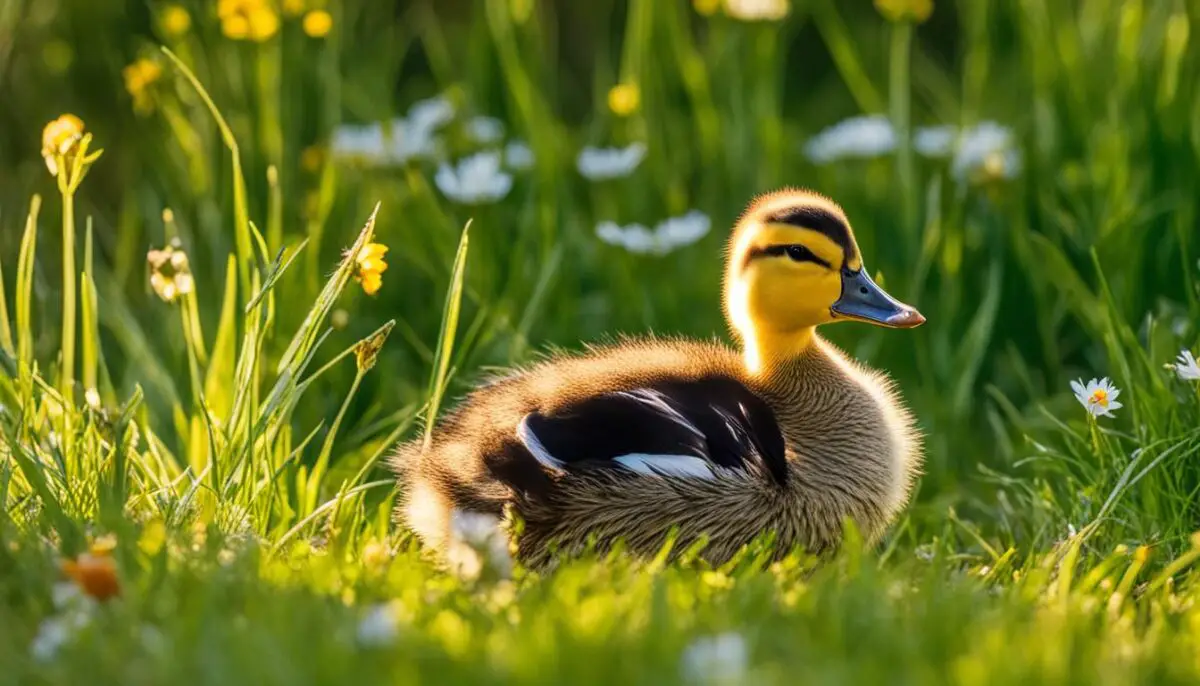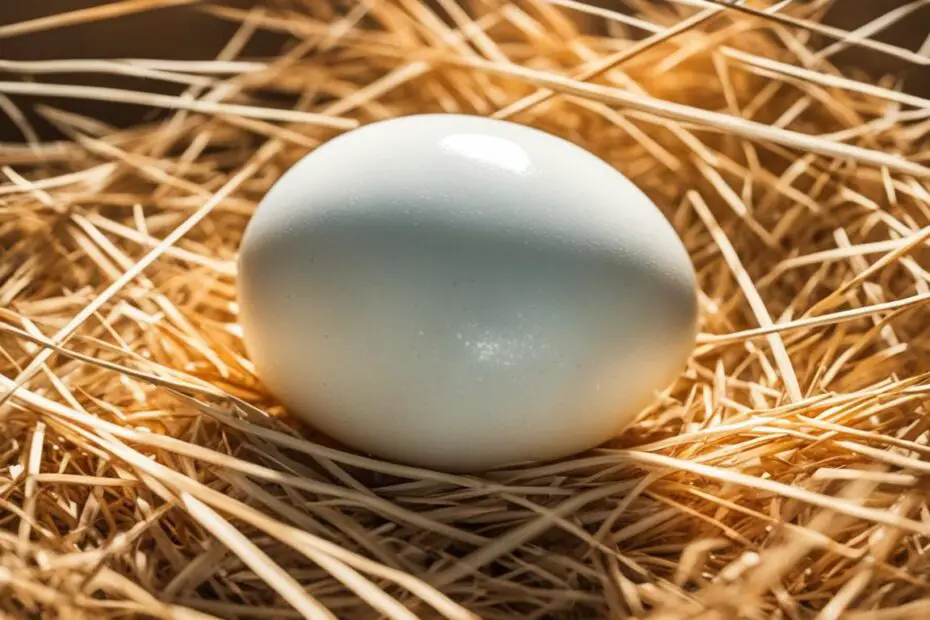Welcome to our guide on duck egg hatching time and the ideal incubation temperature. If you’re a duck enthusiast looking to hatch your own ducklings, it’s important to understand the optimal conditions for successful hatching. By providing the right temperature and following proper incubation practices, you can increase the chances of a successful hatch.
Key Takeaways:
- Duck eggs from common ducks like Pekins require 28 days to hatch, while eggs from Muscovy ducks hatch in about 35 days after setting.
- The temperature for incubating duck eggs should be set at 37.5°C (99.5°F), and the relative humidity at 55% (84.5°F on wet bulb thermometer).
- Eggs must be turned at least 4 times a day.
- It is important to select clean and undamaged eggs for setting and to set them within 1-3 days from the time they were laid.
Incubating Duck Eggs
When it comes to incubating duck eggs, proper temperature and care are crucial for successful hatching. Follow these guidelines to ensure optimal conditions for your duck eggs.
1. Stabilize Temperature and Humidity: Before setting the eggs, start the incubator and allow the temperature and humidity to stabilize for a day or two. This ensures a consistent environment for the eggs to develop.
2. Set the Perfect Temperature: The temperature for duck egg incubation should be set at 37.5°C (99.5°F). This temperature provides the ideal conditions for the embryos to develop.
3. Maintain Proper Humidity: The humidity level in the incubator should be set at 55%. This helps prevent the eggs from drying out and ensures the proper development of the ducklings.
4. Regularly Turn the Eggs: Eggs should be turned at least four times a day to prevent the embryos from sticking to the shell. This can be done either automatically or by hand. Turning the eggs ensures uniform heat distribution and better development.
5. Inspect and Candle the Eggs: Before setting the eggs, it is important to inspect them carefully. Cracked, double yolked, misshapen, oversized, undersized, or dirty eggs should not be used. Candling the eggs helps to determine their viability and monitor embryo development.
6. Correct Positioning: Eggs should be set with the small end down, except in small incubators that have no trays. This helps the ducklings position themselves correctly for hatching.
7. Room Temperature Transition: If the eggs have been stored in a cooler, it is necessary to take them out and allow them to warm to room temperature before setting. Rapid temperature changes can harm the developing embryos.
Follow these steps to create optimal conditions for incubating your duck eggs. By providing the right temperature, humidity, and care, you increase the chances of a successful hatch.

| Natural Incubation | Benefits |
|---|---|
| Broody Duck | Proper care and protection |
| Broody Chicken Hen | Opportunity to hatch duck eggs |
When using a broody duck for natural incubation, it is important to ensure that the nest box is clean and dry. The broody duck should be provided with appropriate feed and water to maintain her health during the incubation period. After the ducklings hatch, they should also have access to feed and water for their proper growth and development.
Similarly, a broody chicken hen can be utilized to hatch duck eggs. The hen will provide warmth and protection, ensuring that the eggs are kept at the optimal temperature for incubation. This natural incubation method can be a convenient option for duck owners who do not have access to an artificial incubator.
“Natural incubation using a broody duck or chicken hen allows for a hands-off approach to hatching duck eggs, while still ensuring a successful hatch.”
Duck Egg Storage
Proper storage of duck eggs is essential for maintaining their hatchability. If you need to store eggs before setting them for incubation, follow these guidelines to ensure optimal conditions.
Temperature and Relative Humidity
Duck eggs should be stored at a temperature of around 55°F (13°C) and a relative humidity of 75%. These conditions help preserve the eggs’ freshness and minimize the risk of spoilage.
Positioning and Cleaning
When storing duck eggs, it is important to position them correctly. Store the eggs with the small end down to help prevent the air sac from detaching and the yolk from shifting. Additionally, do not wash the eggs before storage, as this can remove the protective layer naturally present on the shell.
Duration of Storage
It is crucial to note that the hatchability of duck eggs may decrease the longer they are stored. Therefore, it is best to use stored eggs within a reasonable time frame to maximize the chances of successful hatching.
By following these proper storage practices, you can maintain the quality of duck eggs and increase the likelihood of a successful hatching process.
Duck Egg Storage Guidelines
| Storage Factors | Recommendations |
|---|---|
| Temperature | Around 55°F (13°C) |
| Relative Humidity | 75% |
| Positioning | Small end down |
| Cleaning | Avoid washing |
| Storage Duration | Use within a reasonable time frame |

Candling and Hatching
Candling is a crucial step in the hatching process for duck eggs. It involves shining a light through the eggshell to check for cracks and monitor the development of the embryo. By candling duck eggs at specific points during incubation, you can ensure that the eggs are progressing as they should.
On day 7 of incubation, it is recommended to candle the eggs to identify any infertile or dead eggs. These eggs can be removed to prevent them from affecting the overall hatch rate. By removing these nonviable eggs, you can focus the incubator’s resources on viable ones and increase the chances of a successful hatch.
As the incubation period progresses, on day 25, Pekin eggs should be transferred to hatching trays. This transfer allows for better positioning of the eggs and prepares them for the final stages of hatching. Adjusting the temperature and humidity in the hatcher at this point is essential to create the optimal environment for the eggs to hatch successfully.
Throughout the hatch, it is important to monitor and adjust the humidity and ventilation in the hatcher. Maintaining the correct humidity levels helps prevent the ducklings from drying out too quickly or struggling to emerge from the shells. Adequate ventilation ensures a fresh supply of air for the developing ducklings.
Once the ducklings have hatched, they should be removed from the hatcher when they are dry. Providing a warm and dry environment for the newly hatched ducklings is crucial for their well-being.
| Candling and Hatching Tips |
|---|
| • Use a bright light source for candling, such as a flashlight or a specialized candling device. |
| • Gently rotate the eggs while candling to get a complete view of the egg contents. |
| • Properly clean and disinfect the hatching trays before transferring the eggs. |
| • Monitor the temperature and humidity closely during the hatching process to ensure optimal conditions. |
| • Handle the freshly hatched ducklings with care, as they are delicate and vulnerable. |
Conclusion
Successfully incubating and hatching duck eggs requires careful attention to temperature, humidity, and egg handling. By following proper guidelines, you can increase the chances of a successful hatch and the emergence of healthy ducklings.
To start, maintain an optimal temperature of 37.5°C (99.5°F) throughout the incubation period. This temperature ensures the proper development of the embryos and is crucial for their survival. Additionally, the humidity level should be set at 55% to provide the right conditions for the eggs.
Regular egg turning is vital for the development of the ducklings. Eggs should be turned at least four times a day to prevent the embryo from sticking to the shell and to promote proper growth.
In addition, be sure to select clean and undamaged eggs for incubation. Damaged, dirty, or oversized eggs may lead to developmental issues and reduced hatchability. By choosing the best-quality eggs, you increase your chances of a successful hatch.
If you prefer a natural incubation method, consider using a broody duck or chicken hen. These birds can provide the necessary warmth and care to encourage the eggs to hatch naturally. Just ensure they have access to feed and water throughout the incubation period.
Lastly, proper egg storage and candling are essential for monitoring the progress of the embryos. Store the eggs at around 55°F (13°C) with a relative humidity of 75%. Candling at specific intervals allows you to check for any cracks or signs of embryo development.
With these guidelines in mind, you can confidently embark on the journey of duck egg incubation and experience the joy of hatching healthy ducklings. Best of luck!
FAQ
How long does it take for duck eggs to hatch?
Duck eggs from common ducks like Pekins require 28 days to hatch, while eggs from Muscovy ducks hatch in about 35 days after setting.
What is the optimal temperature for duck egg incubation?
The temperature for incubating duck eggs should be set at 37.5°C (99.5°F).
How often should duck eggs be turned during incubation?
Eggs must be turned at least 4 times a day to ensure proper development.
When should duck eggs be set in the incubator?
It is important to set the eggs within 1-3 days from the time they were laid.
Can duck eggs be hatched naturally?
Yes, duck eggs can be hatched naturally by placing them under a broody duck or even a broody chicken hen.
How should duck eggs be stored before setting?
If eggs need to be stored before setting, they should be stored at around 55°F (13°C) and 75% relative humidity.
What is candling, and when should duck eggs be candled?
Candling is the process of shining a light through the eggshell to check for cracks and embryo development. Duck eggs should be candled at specific points during incubation to monitor their progress.
How should ducklings be removed from the hatcher?
Ducklings should be removed from the hatcher when they are dry.
What is the key to successful duck egg hatching?
Incubating and hatching duck eggs requires careful temperature and humidity control, as well as regular egg turning. Selecting clean and undamaged eggs is important for a successful hatch.

